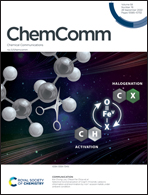The electrodeposition of gold nanoparticles from aqueous nanodroplets†
Abstract
Nanodroplet-mediated electrodeposition is a reliable method for electrodepositing nanoparticles by confining a small amount of metal-salt precursor in water nanodroplets (radius ∼400 nm) suspended in an oil continuous phase. This technique provides a great advantage in terms of nanoparticle size, morphology, and porosity. For an electrochemical reaction to proceed in the aqueous nanodroplet, the electroneutrality condition must be maintained. Classically, [NB4][ClO4] or a comparable salt is added to the oil continuous phase to maintain charge balance. Unfortunately, the presence of this salt in the oil phase causes some metal salts, such as HAuCl4, to phase transfer, disallowing the formation of gold nanoparticles. Here, we demonstrate the partitioning of HAuCl4 is orders of magnitude lower using Inductively Coupled Plasma Mass Spectrometry (ICP-MS) when LiClO4 is added to the nanodroplet phase and [NBu4][ClO4] is not added to the continuous phase. This simple change allows for the electrodeposition of gold nanoparticles. Scanning electron microscopy shows the morphology and size distribution of gold nanoparticles obtained at different concentrations of LiClO4. Transmission electron microscopy in selected diffraction mode was used and it determined the gold nanoparticles obtained are polycrystalline with miller indices of (222) and (200). This work widens the variety of nanoparticles that can be electrodeposited from nanodroplets for applications in energy storage and conversion, photoelectrochemistry, and biosensing.



 Please wait while we load your content...
Please wait while we load your content...